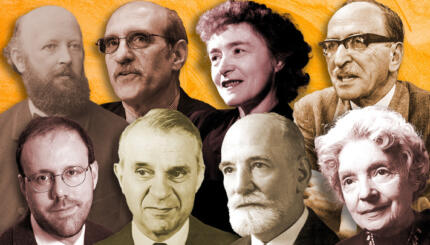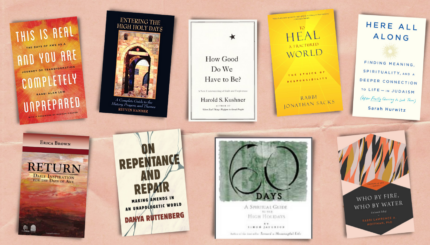Between 1881, when brutal Russian pogroms impelled the Jews of Eastern Europe to head west, and 1924, when the Immigration Act drastically limited the number of Jews who could come to the United States, more than 2.5 million Jews arrived in the country.
Having come to the United States from Central and Eastern Europe, how was the greenhorn Jew to acclimate him- or herself to American life? How much of the European Jewish life would be maintained? And how, precisely, would the competing identities of American and Jew be balanced, and sustained? The slow, and at times shockingly fast, process of adjustment to a new country, and a new way of life, became the subject of American Jewish literature for decades.
Jews had been immigrating to the United States since the colonial era, but it was not until the Russian pogroms of the 1880s, which drove Eastern European Jews in enormous numbers to the country, that the process of making a home in a new country became a central concern of American Jewish letters. Many of the immigrants settled in the cramped tenements of New York City, particularly those of Manhattan’s Lower East Side. The Lower East Side was a place unto itself, its pushcart businessmen, its squalid apartments, and its mix of old-country religion and new-world license symbolic of a place both recognizable and shockingly unfamiliar.
Polish-born Anzia Yezierska (c. 1880-1970), perhaps the best known of this generation of Jewish writers, was both a product of these circumstances, and the mirror that reflected them back to an audience composed in large part of Americans not personally familiar with life in the tenements of the Lower East Side. Yezierska’s short stories, collected in the volume Hungry Hearts (1920), and her novel Bread Givers (1925) are both depictions of the grim circumstances of the Jewish ghettos, and her canny use of the immigrants’ language—part English, part Yiddish, part greenhorn hodgepodge—gives her work a solid grounding in reality. Later, Leo Rosten, writing under an Anglicized nom de plume, Leonard Q. Ross, penned a minor classic of dialect humor, The Education of H*Y*M*A*N K*A*P*L*A*N (1937), whose hilarity stemmed from Rosten’s similarly adept use of Jewish immigrant malapropisms for comic effect.

Help us keep Jewish knowledge accessible to millions of people around the world.
Your donation to My Jewish Learning fuels endless journeys of Jewish discovery. With your help, My Jewish Learning can continue to provide nonstop opportunities for learning, connection and growth.
The subject of the immigrant was an immensely rich one, borne by the native optimism of American life and a counterbalancing pessimism regarding the place of the immigrant—and the Jew in general—in American society. Was it possible for the Jewish immigrant to find his place in America? This was the theme of Abraham Cahan’s towering
novel The Rise of David Levinsky (1917), which spanned the gap between Europe and America in the figure of its eponymous hero. Cahan, a pioneering Yiddish-language journalist and the editor-in-chief for many decades of the Forverts (Forward) newspaper, made Levinsky the symbol of the immigrants’ progress from want to comfort. But David Levinsky, penned in English, is hardly a simple story of triumph. Its protagonist, having received much of America’s copious bounty, is unsure, at the very end, if he has been blessed or punished. Mary Antin approached the same question from a differing perspective, writing about her own journey from Russia to Boston, and her life as a writer, suffragette, and advocate for Jewish immigrants like herself. Antin was so persuasive as an advocate for women’s rights to vote that none other than Theodore Roosevelt credited her with convincing him of the justice of the cause. Antin’s memoir The Promised Land (1912) meant its title literally, painting a portrait of America as a land of plenty.
These Jewish writers were not just reflecting the circumstances of immigration; they were often changed by it, too. Mike Gold—originally Granik but borrowing his pseudonym from a Civil War veteran—was a novelist and Communist activist, and his book Jews Without Money (1930), the title alone a pointed barb, offers, in the words of critic Morris Dickstein, an array of, “brutal snapshots of street and tenement life… a series of dreamlike memories leading to a final awakening.” This awakening takes the form of a quasi-religious fantasy of violent uprising: “O workers’ Revolution, you brought hope to me, a lonely, suicidal boy. You are the true Messiah. You will destroy the East Side when you come, and build there a garden for the human spirit.”
Among the writers Cahan imported from Europe for employment at the Forverts was the novelist Israel Joshua Singer, later best known as the older brother of Nobel Laureate Isaac Bashevis Singer. I.J. Singer had already written his classic novel of European Jewish life, The Brothers Ashkenazi (1936), when he began work on a multi-generational family novel whose latter sections are set in America. The Family Carnovsky (1969)–its family name perhaps serving as inspiration for the title Philip Roth gives to his character Nathan Zuckerman’s novel Carnovsky–echoes its predecessor in its narrative sweep, and in its sense of family stories playing out over the progression from father to son to grandson. The Family Carnovsky ends on Manhattan’s Upper West Side, where the dreams of European Jewry seemingly go to die in empty consumerism and the abandonment of millennia of tradition.
Jewish writers, many of them from New York City, kept returning to their old neighborhoods for inspiration, charged by their own memories and the lives of their friends and neighbors. Sholem Asch‘s East River (1946) plumbed the depths of Manhattan’s far East Forties, documenting the clammy interactions between Jew and gentile. And Henry Roth, only rediscovered by a substantial audience in the 1960s, wrote Call It Sleep in 1934, drawing on his Lower East Side childhood. The book is purposefully limited in its scope, preferring to keep to a child’s perspective, allowing readers to  intuit the matters Roth’s youthful protagonist cannot yet grasp. His Lower East Side is a place of shame and fear, though occasional hope. Roth, in Dickstein’s analysis, “portrays the world of the ghetto through the prism of the family romance.” The world of Call It Sleep is sweet and unbearably savage, a romance and a tragedy all at once. Re-emerging in the 1960s, Roth would serve as an inspiration to the Jewish writers of postwar America.
intuit the matters Roth’s youthful protagonist cannot yet grasp. His Lower East Side is a place of shame and fear, though occasional hope. Roth, in Dickstein’s analysis, “portrays the world of the ghetto through the prism of the family romance.” The world of Call It Sleep is sweet and unbearably savage, a romance and a tragedy all at once. Re-emerging in the 1960s, Roth would serve as an inspiration to the Jewish writers of postwar America.
The story of the Jewish immigrant in American literature hardly ends there. After the lauded generation of Roth, Bernard Malamud and others wrote about them as their parents, a new generation of American Jewish writers, most with little firsthand experience of immigrants, adopted the stories of their grandparents’ generation as their own.
Jonathan Safran Foer‘s Everything Is Illuminated (2003), Nicole Krauss’ The History of Love (2006), and Michael Chabon’s The Yiddish Policemen’s Union (2008) borrowed the Yiddish culture and Eastern European roots of the Jewish past for their historically infused tales of past meeting present. And young, contemporary writers like Gary Shteyngart and David Bezmozgis are themselves immigrants from the former Soviet Union, their wise, witty stories of fearful parents, world- weary children, and overbearing relatives, like Shteyngart’s The Russian Debutante’s Handbook (2003) and Bezmozgis’ Natasha and Other Stories (2005) are direct descendants, updated for the modern age, of writers like Yezierska and Cahan. As far as American Jews have traveled, and as many inroads as they have made into the mainstream of the country’s life, the immigrant’s tale remains fundamentally their own.


